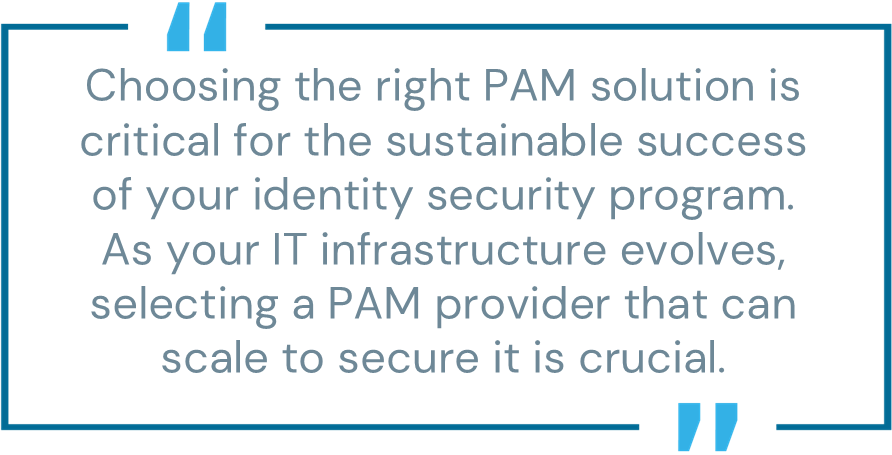
In 2025, global cybersecurity trends like the rise of Zero Trust, tightening data privacy and AI regulations and growing concerns over cloud security will only accelerate. Each of these evolving forces will also shift paradigms for the privileged access management (PAM) programs charged with safeguarding IT, cloud ops and third-party vendor users as they perform high-risk operations.
PAM is considered an essential best practice for a Zero Trust security posture. Many regulators, audit frameworks and cyber insurers actively require PAM controls like credential management, session monitoring and implementation of least privilege access. Organizations know that to holistically protect the highest-risk accounts and roles in their hybrid and multi-cloud environments from attacks, they need effective and scalable PAM programs.
That word—program—is extremely important, as organizations can’t treat PAM as a one-time effort. Rather, PAM must be a continuous discipline composed of people, processes and technology. It’s critical to consistently discover, secure and measure privileged access risk using automation to ensure ongoing protection across evolving environments.

Choosing the right PAM solution is critical for the sustainable success of your identity security program. As your IT infrastructure evolves, selecting a PAM provider that can scale to secure it is crucial.
Here’s what to look for in a technology provider for your modern PAM program:
1. Proven Track Record of Security and Resiliency
Because PAM programs secure an organization’s highest-risk administrative accounts and roles, people frequently describe them as protecting the ‘crown jewels’ or the ‘keys to the kingdom.’ For this reason, it’s critical to choose a PAM provider you can trust for this responsibility. A strong security history should be a fundamental requirement for any PAM evaluation.
In recent years, many vendors offering PAM capabilities have suffered from identity-related breaches stemming from stolen privileged credentials and API Keys, service accounts and accounts used by engineers. In December 2024, a nation-state advanced persistent threat (APT) even breached a U.S. Federal Government agency by compromising the agency’s PAM solution. In this scenario, the breach of the leading PAM provider came from a compromised API key (a privileged credential used by machine identities). This vendor failed to secure the keys to their own kingdom.
When planning your PAM implementation, look for proven security and resiliency. Other vendors in the PAM market have had to announce outages and security vulnerabilities directly impacting PAM operations.
Don’t gamble with the keys to your kingdom. Carefully evaluate the security of your security stack, especially PAM solutions. Organizations should check CVEs and breaches related to potential PAM providers. Another important evaluation criterion should be external certifications like AICPA SOC 2, FedRAMP and ISO 27001 for SaaS solutions or DoDIN APL for self-hosted software.
Many vendors publicly document their certifications and internal security practices on trust center pages. You can also verify the security reputation of a potential PAM provider by asking your auditor, cyber insurance underwriter or IT service provider for a recommendation.
2. Established Success—and Scalability—in Your Industry
Another core requirement for a PAM provider should be a successful track record in your industry. Vendors with industry-specific expertise understand your challenges and regulatory requirements, which helps to ensure they can provide tailored solutions that meet your needs.
Established success demonstrates a vendor’s ability to deliver reliable and effective services, reducing the risk of implementation issues or adoption challenges with industry-specific technologies such as SCADA systems in operational technology and manufacturing or electronic health records (EHRs) in healthcare.
Scalability is also important. Nearly every business is growing the infrastructure, data and software powering its performance. With every new machine, server, application and employee in an organization, new identities must be secured. To future-proof your PAM strategy, look for vendors with reference customers in your industry that have long operated securely and at scale.
3. Baseline PAM Controls That Won’t Keep You Running Back to Market
To avoid wasted time and resources, choose a PAM provider that can solve all your use cases. Some PAM tools solve individual use cases but require integration with additional PAM platforms for foundational controls like removal of local admin rights, secrets management for machine identities or, in some cases, even management of admin accounts and credentials.
Each of these use cases is a common audit requirement, so if you choose a PAM vendor that can’t address them, you will still need to spend money, time and effort integrating another solution.
Look to standardize your PAM program with the following baseline capabilities:
- Automated discovery and onboarding of privileged access.
- Implementation of least privilege access—from the endpoint to the cloud. Look for role-based access control (RBAC) mechanisms that support access across multi-cloud systems.
- Effective credential management. After discovery, look for secure credential management, policy-based credential rotation and reconciliation. Leading solutions provide these controls for all credential types, including local admin passwords, domain passwords, SSH and API keys, workforce passwords and application secrets.
- Session isolation and monitoring. Look for native isolation of workstations from target systems to prevent the spread of malware, with or without credentials. Real time session monitoring and recording in these sessions is imperative for smooth audits.
- Support for third-party vendors. You need to secure remote access for the external vendors and contractors you currently—and may someday—rely on for specialized tasks. Features like just-in-time (JIT) access, granular RBAC permissions and centralized audit help ensure external access is tightly controlled and monitored.
4. Ability to Satisfy Your Unique Audit, Compliance and Cyber Insurance Requirements
Organizations need PAM solutions across industries that facilitate audit and regulatory compliance and simplify associated processes.
Leading PAM solutions offer capabilities and reports that streamline compliance with various standards and regulations, such as SOX, SOC 2, SWIFT, HIPAA and PCI DSS. Frequent requirements across these frameworks include the implementation of least privilege and detailed audit trails of privileged access. Quality PAM solutions offer detailed logging and screen recordings to support these audits while enabling certification and reporting of all roles and privileges.
Cyber insurance providers also increasingly require PAM controls like removing local admin rights on workstations and implementing multi-factor authentication (MFA) in privileged sessions. When building a PAM program, consider working with vendors directly offering these controls without requiring additional investments.
To increase efficiency and automation of audit and compliance efforts, look for PAM solutions that offer centralized audit across all privileged session types—whether a user is accessing on-prem, OT, cloud or web app resources. With centralization, auditors need just one screen—not several, allowing them to reduce wasted time.
Additionally, leading PAM solutions now use artificial intelligence to summarize sessions for auditors and provide Identity Threat Detection and Response (ITDR) capabilities for security operations center (SOC) teams. Both these capabilities can increase efficiency and automation for your PAM program.
5. Integrations with Your Existing Tech Stack
PAM programs that don’t easily integrate with an organization’s existing IT and security tools are doomed. Integration is essential not only for a cohesive security posture but also for adoption from end users, who want minimal changes to the way they work.
Be sure to choose a PAM solution that offers free, out-of-the-box integrations with your tech stack. Common integration points include Identity and Access Management (IAM) systems, security information and event management (SIEM) tools and any ChatOps and IT Service Management (ITSM) ticketing systems your organization has in place for change management and approvals. Look for vendors that publicly document their free integrations.
And beware of vendors charging for professional services to integrate PAM with your third-party software. This practice not only signals the complexity of the PAM solution in question but can also increase your total cost of ownership (TCO) and strain operational efficiency whenever your organization adds new technology. Be cautious about working with these vendors.
6. Scalability to the Cloud and Cloud-friendly Access Models
It’s imperative to secure high-risk access wherever it lives. Yet many PAM providers still fail to scale in public cloud environments. Some PAM solutions first designed for long-lived, on-premises systems lack the flexibility to secure role-based federated access to cloud resources.
Cloud providers advocate for modern PAM approaches that enable access to roles (not accounts) with zero standing privileges (ZSP). In a ZSP, users have no access rights until the exact moment they are needed. Permissions are created on the fly for a specific user’s session, subject to an automated or manual approval process. After the permissions are used, they are removed at the end of a time-bound and recorded session. This approach reduces the risk of credential theft since the credential does not exist. It also protects against privilege misuse and lateral movement since no IT user has standing access to cloud resources.
Many new vendors entering the PAM market claim ZSP capabilities. Carefully evaluate these claims. In reality, very few technologies can create and delete permissions on the fly. Carefully evaluate any solution trusted with securing privileged access, comparing your organization’s needs with claims from any vendor (including CyberArk).
7. Native User Experience to Accelerate Adoption With Your Crankiest IT Users
Tech-savvy IT and engineering users will out-engineer a bad user experience. When PAM solutions don’t provide a low-friction UX, end users will find a way around them, exposing the organization to new security and audit risks.
Conversely, a native, user-friendly experience leads to greater risk reduction from wide adoption. Look for PAM providers that allow end users to use their preferred, native tools to connect to target systems in any environment—whether end users connect using vaulted credentials or with zero standing privileges.
Look for PAM solutions that protect the following use cases for native access:
- Windows infrastructure and domain controllers with controls applied in Remote Desktop Protocol (RDP) sessions.
- Linux infrastructure and VMs with controls applied in Secure Socket Shell (SSH).
- Databases, whether on-prem or in the cloud, with controls applied in native database clients.
- Kubernetes and containerized workloads with controls applied in kubeCTL and other native tooling.
- Cloud services with privilege controls applied in cloud management web consoles and AWS, Azure and GCP command line interfaces (CLIs).
Choosing the right PAM solution in 2025 involves building from a secure, resilient baseline and expanding to tackle advanced use cases. By starting with today’s scalability and user experience requirements, you can select a PAM solution that meets their needs and safeguards their critical assets in the ever-evolving IT landscape.
And always remember—PAM is a continuous program, not a one-time effort. Be sure to consider people, processes and technology factors in your evaluation.
Want to learn more about how to secure access to your most critical assets? Check out CyberArk’s Buyer’s Guide for Securing Privileged Access.
Sam Flaster is a director of product marketing at CyberArk.





















